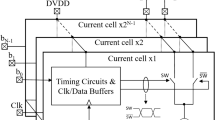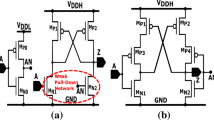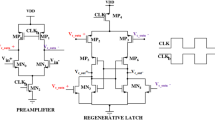Abstract
This brief proposes a two-stage cascoded CMOS LNA with common drain envelope detection based power reduction method for the 5G applications of 28 GHz frequency. Dual inductive peaking and stagger tuning techniques are involved to get a 3 dB bandwidth of 2.25 GHz from 26.75 to 29 GHz. Besides, 22 dB of gain is provided by the proposed LNA. Inductive source degeneration helps to reduce the Noise Figure (NF) of the first cascoded stage, and a 2.3 dB of NF is observed in the LNA. The primarily amplified signals from the first cascoded stage are fed to the envelope detector and the second cascoded stage. When the RF signal is received, the envelope detector output will be high, and it turns on the second cascoded stage. In the existing method, the combination of a diode-connected transistor, low pass filter and buffer has been used for the envelope detection. A common drain transistor with an active resistor and capacitor is used in the envelope detection of the proposed method. Here, the power consumption of the LNA is reduced by 25.26% at the sleep mode. The proposed LNA consumes 9.5 mW and 7.1 mW of power from a 1.5 V supply at the active state and sleep state respectively. It requires 0.1235 mm2 of core area in 90 nm technology. Moreover, the behavior of the circuit under process corner variation and temperature variation is analyzed, and Monte–Carlo analysis is performed.










Similar content being viewed by others
References
Roobert, A. A., & Rani, D. G. N. (2019). Survey on parameter optimization of mobile communication band low noise amplifier design. International Journal of RF and Microwave Computer‐Aided Engineering. https://doi.org/10.1002/mmce.21720.
GPP TS 38.101-2. NR, User EquipmeNt (UE) Radio Transmission and Reception Part 2: Range 2 Standalone. Technical Specification (TS) 38.101-2, 3rd Generation Partnership Project (3GPP), 01 2018. Version 15.0.0.
Fritsche, D., Tretter, G., Carta, C., & Ellinger, F. (2015). Millimeter-wave low-noise amplifier design in 28-nm low-power digital CMOS. IEEE Transactions on Microwave Theory and Techniques, 63, 1910–1922. https://doi.org/10.1109/TMTT.2015.2427794.
Roobert, A. A., Rani, D. G. N., Divya, M., & Rajaram, S. (2018). Design of CMOS based LNA for 5G wireless applications. In Proceedings of the 6th international conference on communications and broadband networking—ICCBN 2018 (pp. 43–47) ACM Digital Library, NTU Singapore. https://doi.org/10.1145/3193092.3193095.
Alam, S. K., & Degroat, J. (2008). A 2 GHz variable gain low noise amplifier in 0.18-μm CMOS. Analog Integrated Circuits and Signal Processing, 56, 37–42. https://doi.org/10.1007/s10470-007-9080-6.
Nguyen, T. K., Kim, C. H., Ihm, G. J., Yang, M. S., & Lee, S. G. (2004). CMOS low-noise amplifier design optimization techniques. IEEE Transactions on Microwave Theory and Techniques, 52, 1433–1442. https://doi.org/10.1109/TMTT.2004.827014.
Parvizi, M., Allidina, K., & El-Gamal, M. N. (2016). An ultra-low-power wideband inductorless CMOS LNA with tunable active shunt-feedback. IEEE Transactions on Microwave Theory and Techniques, 64, 1843–1853. https://doi.org/10.1109/TMTT.2016.2562003.
Fletcher, N. M., Gambini, S., & Rabaey, J. M. (2008). A 2 GHz 52 μW wake-up receiver with − 72 dBm sensitivity using uncertain-IF architecture. In International solid-state circuits conference-digest of Technical Papers (Vol. 51, pp. 524–526). https://doi.org/10.1109/isscc.2008.4523288.
Hsieh, J.-Y. (2018). Low-noise amplifier by using a signal-reuse wake-up technology. IET Microwaves, Antennas and Propagation, 12, 287–294. https://doi.org/10.1049/iet-map.2017.0700.
Kalamani, C. (2019). Design of differential LNA and double balanced mixer using 180 nm CMOS technology. Microprocessors and Microsystems, 71, 102850. https://doi.org/10.1016/j.micpro.2019.102850.
Roobert, A. A., & Rani, D. G. N. (2019). Design and analysis of 0.9 and 2.3 GHz concurrent dual band CMOS LNA for mobile communication. International Journal of Circuit Theory and Applications. https://doi.org/10.1002/cta.2688.
Roobert, A. A., Rani, D. G. N., & Rajaram, S. (2019). Design and optimisation of feedforward noise cancelling complementary metal oxide semiconductor LNA for 2.4 GHz WLAN applications. IET Circuits, Devices and Systems. https://doi.org/10.1049/iet-cds.2018.5291.
Bondarev, O., Mirvoda, D., Kosogor, A., & Tikhov, Y. (2018). A line of 4–40 GHz GaAs low noise medium power amplifiers for SDH relay stations (pp. 187–190).
Tong, X., Zhang, S., Zheng, P., Xu, J., & Shi, X. (2018). 18–31 GHz GaN MMIC LNA using a 0.1 um T-gate HEMT process. In 2018 22nd international microwave and Radar conference (pp. 500–503).
Elkholy, M., Shakib, S., Dunworth, J., Aparin, V., & Entesari, K. (2018). A wideband variable gain LNA with high OIP3 for 5G using 40-nm bulk CMOS. IEEE Microwave and Wireless Components Letters, 28, 64–66. https://doi.org/10.1109/LMWC.2017.2779832.
Hedayati, M. K., Abdipour, A., Shirazi, R. S., Cetintepe, C., & Staszewski, R. B. (2018). A 33-GHz LNA for 5G wireless systems in 28-nm bulk CMOS. IEEE Transactions on Circuits and Systems II: Express Briefs, 65, 1460–1464. https://doi.org/10.1109/TCSII.2018.2859187.
Luo, J., He, J., Wang, H., Chang, S., Huang, Q., & Yu, X. P. (2018). A 28 GHz LNA using defected ground structure for 5G application. Microwave and Optical Technology Letters, 60, 1067–1072. https://doi.org/10.1002/mop.31112.
Chauhan, V., & Floyd, B. (2018). A 24–44 GHz UWB LNA for 5G cellular frequency bands. In 2018 11th global symposium on millimeter waves (GSMM) (pp. 18–20). https://doi.org/10.1109/gsmm.2018.8439672.
Ciccognani, W., Colangeli, S., Longhi, P. E., & Limiti, E. (2019). Design of a MMIC low-noise amplifier in industrial gallium arsenide technology for E-band 5G transceivers. Microwave and Optical Technology Letters, 61, 205–210. https://doi.org/10.1002/mop.31536.
Ciccognani, W., Longhi, P. E., Colangeli, S., & Limiti, E. (2018). Q/V band LNA for satellite on-board space applications using a 70 nanometers GaAs mHEMT commercial technology. Microwave and Optical Technology Letters, 60, 2185–2190. https://doi.org/10.1002/mop.31317.
Longhi, P. E., Pace, L., Colangeli, S., Ciccognani, W., Leblanc, R., & Limiti, E. (2020). V-band GaAs metamorphic low-noise amplifier design technique for sharp gain roll-off at lower frequencies. IEEE Microwave and Wireless Components Letters, 30, 601–604. https://doi.org/10.1109/LMWC.2020.2986927.
Author information
Authors and Affiliations
Corresponding author
Ethics declarations
Conflict of interest
On behalf of all authors, the corresponding author states that there is no conflict of interest.
Additional information
Publisher's Note
Springer Nature remains neutral with regard to jurisdictional claims in published maps and institutional affiliations.
Rights and permissions
About this article
Cite this article
Roobert, A.A., Rani, D.G.N. Design and analysis of a sleep and wake-up CMOS low noise amplifier for 5G applications. Telecommun Syst 76, 461–470 (2021). https://doi.org/10.1007/s11235-020-00729-y
Accepted:
Published:
Issue Date:
DOI: https://doi.org/10.1007/s11235-020-00729-y




